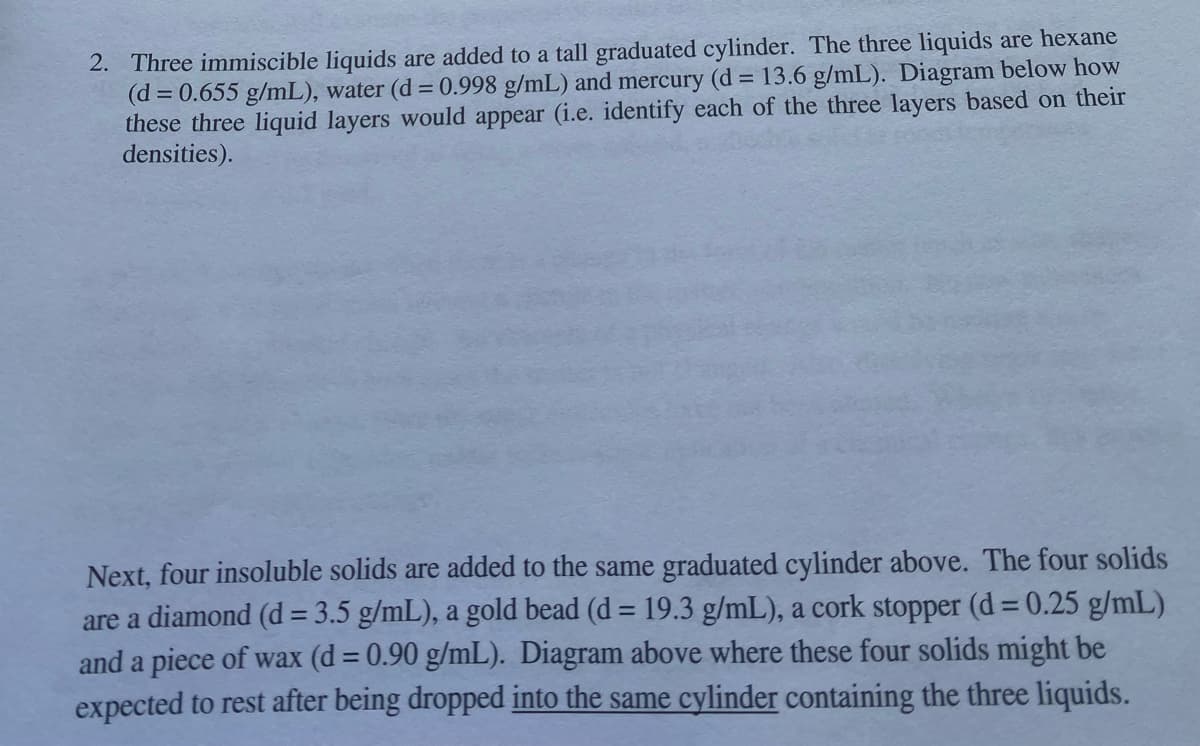2. Three immiscible liquids are added to a tall graduated cylinder. The three liquids are hexane (d = 0.655 g/mL), water (d = 0.998 g/mL) and mercury (d = 13.6 g/mL). Diagram below how these three liquid layers would appear (i.e. identify each of the three layers based on their densities). Next, four insoluble solids are added to the same graduated cylinder above. The four solids are a diamond (d = 3.5 g/mL), a gold bead (d = 19.3 g/mL), a cork stopper (d = 0.25 g/mL) and a piece of wax (d = 0.90 g/mL). Diagram above where these four solids might be expected to rest after being dropped into the same cylinder containing the three liquids. %3D %3D %3D
2. Three immiscible liquids are added to a tall graduated cylinder. The three liquids are hexane (d = 0.655 g/mL), water (d = 0.998 g/mL) and mercury (d = 13.6 g/mL). Diagram below how these three liquid layers would appear (i.e. identify each of the three layers based on their densities). Next, four insoluble solids are added to the same graduated cylinder above. The four solids are a diamond (d = 3.5 g/mL), a gold bead (d = 19.3 g/mL), a cork stopper (d = 0.25 g/mL) and a piece of wax (d = 0.90 g/mL). Diagram above where these four solids might be expected to rest after being dropped into the same cylinder containing the three liquids. %3D %3D %3D
ChapterU6: Showtime: Reversible Reactions And Chemical Equilibrium
Section: Chapter Questions
Problem 10STP
Related questions
Question
Please Help

Transcribed Image Text:2. Three immiscible liquids are added to a tall graduated cylinder. The three liquids are hexane
(d = 0.655 g/mL), water (d = 0.998 g/mL) and mercury (d = 13.6 g/mL). Diagram below how
these three liquid layers would appear (i.e. identify each of the three layers based on their
densities).
Next, four insoluble solids are added to the same graduated cylinder above. The four solids
are a diamond (d = 3.5 g/mL), a gold bead (d = 19.3 g/mL), a cork stopper (d = 0.25 g/mL)
and a piece of wax (d = 0.90 g/mL). Diagram above where these four solids might be
expected to rest after being dropped into the same cylinder containing the three liquids.
%3D
%3D
Expert Solution
This question has been solved!
Explore an expertly crafted, step-by-step solution for a thorough understanding of key concepts.
This is a popular solution!
Trending now
This is a popular solution!
Step by step
Solved in 2 steps with 1 images

Knowledge Booster
Learn more about
Need a deep-dive on the concept behind this application? Look no further. Learn more about this topic, chemistry and related others by exploring similar questions and additional content below.Recommended textbooks for you


World of Chemistry, 3rd edition
Chemistry
ISBN:
9781133109655
Author:
Steven S. Zumdahl, Susan L. Zumdahl, Donald J. DeCoste
Publisher:
Brooks / Cole / Cengage Learning

Introductory Chemistry: A Foundation
Chemistry
ISBN:
9781337399425
Author:
Steven S. Zumdahl, Donald J. DeCoste
Publisher:
Cengage Learning


World of Chemistry, 3rd edition
Chemistry
ISBN:
9781133109655
Author:
Steven S. Zumdahl, Susan L. Zumdahl, Donald J. DeCoste
Publisher:
Brooks / Cole / Cengage Learning

Introductory Chemistry: A Foundation
Chemistry
ISBN:
9781337399425
Author:
Steven S. Zumdahl, Donald J. DeCoste
Publisher:
Cengage Learning

Chemistry: Principles and Practice
Chemistry
ISBN:
9780534420123
Author:
Daniel L. Reger, Scott R. Goode, David W. Ball, Edward Mercer
Publisher:
Cengage Learning

Introductory Chemistry: An Active Learning Approa…
Chemistry
ISBN:
9781305079250
Author:
Mark S. Cracolice, Ed Peters
Publisher:
Cengage Learning

Chemistry: An Atoms First Approach
Chemistry
ISBN:
9781305079243
Author:
Steven S. Zumdahl, Susan A. Zumdahl
Publisher:
Cengage Learning